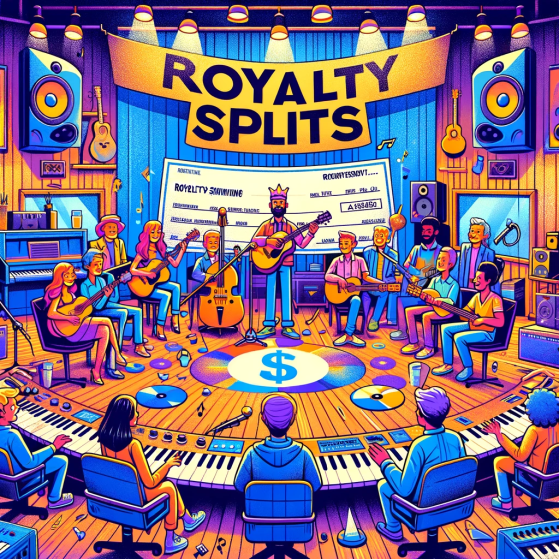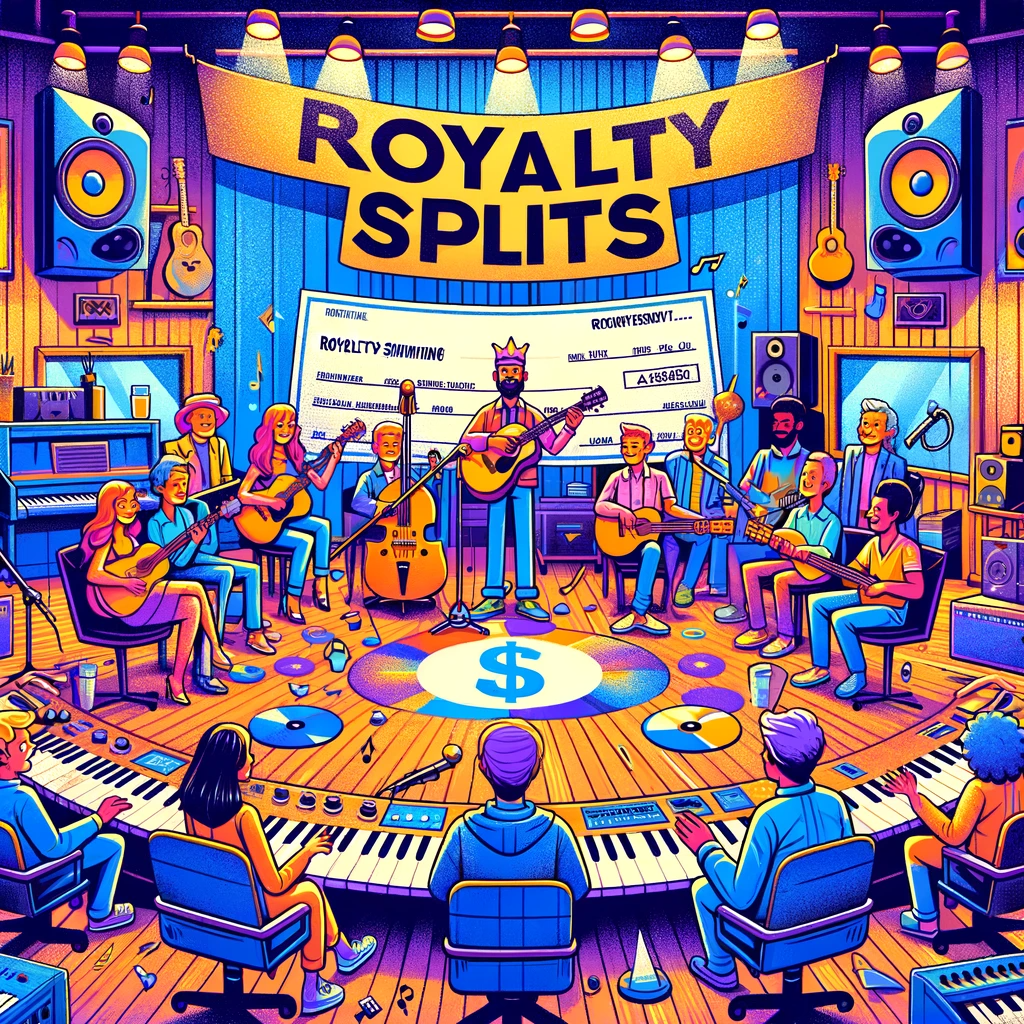Introduction to Royalty Splits and its Importance
In the music industry, one of the most important aspects that artists must understand is how royalty splits work. For many songwriters and musicians, these payments represent a significant portion of their income. Thus, becoming familiar with the mechanics behind them is crucial to their financial success.
Understanding Royalty Splits
Royalty splits refer to the division of earnings collected from a song or an album. This split includes profits derived from sales, streaming, synchronization fees (used in movies, commercials, etc.), performance royalties (when the song is performed live), and mechanical royalties (from reproduction of recordings). The portion each individual receives depends on their contribution and agreement with other creators involved in the project.
Collaborators may choose to split the profits evenly or have percentages based on contribution. It’s essential to determine this split at the outset to prevent misunderstandings and potential disputes down the line. An agreement, preferably written, should be finalized before the song is fully developed or released.
The Role of Collaborations and Co-Writing
In many cases, songs are not the product of a single mind but the combined efforts of multiple individuals. These people could include songwriters, producers, recording artists, and even sound engineers. All participants who add significant value to the song should be included in the royalty splits.
Co-writing is also a common practice that contributes to the complexity of royalty splits. With more authors involved, there is an intricate task of determining who contributed what and how much they deserve from the royalty pot. As with collaborations, agreements on splits should be clarified and documented ahead of time.
The Implication of Royalty Splits
As the music industry evolves, so do the ways in which royalties are split. Nowadays, with the prevalence of digital platforms like Spotify and Apple Music, and the rise of independent artists, understanding royalty splits is more important than ever. These splits can significantly affect an artist’s revenue and influence future collaborations.
In conclusion, royalty splits serve an essential role in the music industry, particularly for those involved in collaborations and co-writing. Achieving a clear understanding of how these splits work and setting fair agreements can be the difference between a thriving career and potential disputes. This knowledge also empowers artists to negotiate better deals, ensuring they are adequately rewarded for their hard work and creativity.

Key Concepts in Understanding Royalty Splits
Basics of Royalty Splits
Royalty splits pertain to the division of profits among creators from a certain creative work. This concept is prevalent in several industries, most notably music, literature and art. In the context of music, each time a song earns revenue, for instance via streaming platforms, physical sales, or radio plays, the individuals who contributed to its creation are entitled to a portion of these earnings. This, essentially, is their royalty split.
The Importance of Royalty Agreements
Determining royalty splits typically happens during the creation process, with percentages being agreed upon by all parties involved. It’s crucial that co-creators have clear, written agreements outlining percentage splits, to avoid misunderstandings and conflicts in the future.
A key distinction to note is that royalty splits don’t necessarily reflect the amount of work each contributor has put in. The distribution might be equal, or it might favor a particular member depending on factors like their reputation, their role in the project, or terms outlined in a pre-existing contract.
Types of Royalties in Music Collaboration
In music collaborations, royalties can be further categorized into different types: mechanical royalties from the reproduction of songs on CDs, vinyl, and digital formats; performance royalties generated from radio broadcasts, live concerts, streaming, etc.; and synchronization royalties earned when a song is used in movies, advertisements, TV shows, and more.
Each category presents unique considerations in terms of royalty splits. Therefore, understanding these categories is important for artists navigating the often-complex world of royalty divisions.
Exploring Royalty Splits in Collaborations
Defining Royalty Splits in Collaborations
In a collaboration, royalty splits are an essential tool for dividing earnings from the release of a collaborative work. These splits determine how much each party involved will make from sales, streaming, licensing, and other revenue channels.
Agreeing on royalty splits between all parties is often a challenging process due to factors such as varying input levels, industry standards, and negotiations.
Typically, royalty splits are determined by the overall contribution to the project, whether it’s writing, producing, performing, or some other creative input. It’s essential to note that all collaborators should have a clear understanding of their percentage before the release of the final product to avoid potential conflicts.
Common Practice in Determining Royalty Splits
The most common practice in determining royalty splits is equal division among all collaborators. For instance, if there are four co-writers, each would receive 25% of the royalties.
This method is considered fair and uncomplicated, especially when all contributors have equally participated in the creation process.
However, in situations where contributions are not equal, royalty splits might be calculated differently. The collaborator who wrote the lyrics might get a particular percentage while the one who composed music might get another. These splits depend largely on the agreement reached upon by all collaborators.
Importance of Written Agreements in Royalty Splits
Written agreements play a crucial role when negotiating royalty splits. These agreements provide clarity and protect the rights of all parties involved. They outline clearly the percentage each collaborator will receive from the revenues generated through various sources.
A written agreement, also known as a split sheet, includes things like the names of all collaborators, their respective publishing entities, their Performance Rights Organization affiliations, and, most importantly, their individual share of the royalties. Having this information documented can prevent future disputes, ensure transparency, and maintain long-standing professional relationships among collaborators.
Dealing with Royalty Splits in Co-Writing
Understanding Royalty Splits in Co-Writing
When two or more songwriters collaborate on a song, they are usually involved in splitting the royalties that are generated from their work. It’s important to understand that when you co-write a song, the music and lyrics collectively form one single work of art.
This means every single writer inherently owns an equal share. Unless specified otherwise, the law generally assumes that all contributors equally worked on the song, hence the split is 50/50 or divided evenly among multiple writers.

Negotiating Co-Writing Royalty Splits
In most cases, the royalty splits between the co-writers are determined by a mutual agreement. It doesn’t necessarily have to be equal, though it often is in the absence of any stated agreement. The amount each co-writer receives will depend largely on how much they contributed to the creation of the song with regard to both the lyrics and the melody.
Proportions can vary; for example, one writer may get 40% of the royalties while the other receives 60%, or it could be an equal 50/50 split if both had equal contribution.
To avoid misunderstandings down the road, it’s best to discuss and agree upon the royalty split at the time of writing the song, or as soon afterwards as possible. Ensure this agreement is in writing and understood by all parties involved.
The Role of Publishing Companies in Co-Writing Royalty Splits
Publishing companies play a crucial role in managing and administering the rights associated with royalty splits in co-writing. Depending on the contracts signed by the writers, a publishing company may collect and distribute royalties, handle licensing requests, and safeguard the copyright of the work.
The company collects a portion of the royalties as payment for their services, but the rest should be distributed according to the splits agreed upon by the co-writers. It’s important for all co-writers to understand the terms of their publishing agreements and how these may influence their royalty splits.
Conclusions and Best Practices for Managing Royalty Splits
Establishing Clarity from the Outset
The first best practice for managing royalty splits is to establish clarity from the very outset of any collaboration. Engaging in detailed conversations about the division of royalty splits at the beginning of a project can prevent costly disagreements down the line.
A thorough discussion should cover such topics as who will be considered a songwriter and entitled to royalties, whether all participants will share equally in these royalties, or if different individuals’ contributions will be given weighted value.
Documenting Agreements
Paperwork might seem tedious, but in the world of co-writing and collaborations, it’s absolutely critical. Every agreement on royalty splits should be documented in writing, providing a reference point in case of future disputes.
Recommended forms of documentation include split sheets, publishing contracts, or other legal documents that explicitly detail who owns what percentage of the song. Even emails exchanged regarding these arrangements can serve as valid proof in some cases.
Maintaining Open Communication
Maintaining open lines of communication throughout the collaborative process is another key to successfully managing royalty splits. This could involve regular check-ins to discuss how each party feels the project is progressing and how contributions are being valued. It’s also important to communicate openly about any new deals or opportunities that could affect the royalty splits.
By fostering a collaborative environment where everyone feels heard and valued, you can minimize the likelihood of disputes and misunderstandings.




